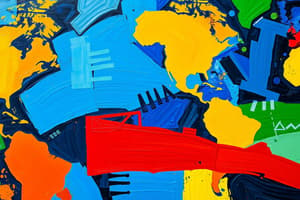Podcast
Questions and Answers
Which factor is LEAST likely to drive globalization?
Which factor is LEAST likely to drive globalization?
- Stricter enforcement of trade barriers. (correct)
- Increased foreign direct investment.
- New forms of transportation such as cold chain logistics.
- Advancements in global communication technologies.
How does international trade typically foster interdependence among nations?
How does international trade typically foster interdependence among nations?
- By specializing in different sectors and relying on other countries for goods and services they don't produce. (correct)
- By increasing trade barriers to protect domestic industries.
- By decreasing the flow of migration and money to maintain economic stability.
- By encouraging nations to become completely self-sufficient in all industries.
A company decides to outsource its manufacturing to a country with lower labor costs. What is the MOST likely result of this decision, regarding global market dynamics?
A company decides to outsource its manufacturing to a country with lower labor costs. What is the MOST likely result of this decision, regarding global market dynamics?
- There will likely be a decrease in innovation as the company relies on cheaper labor instead of technology.
- The company will likely contribute to increased poverty in both the outsourcing country and its home country.
- The company will likely become less competitive due to increased transportation costs.
- The company will likely be able to offer products at lower prices, increasing competitive pressure on domestic firms. (correct)
What is the MOST direct effect of reduced trade barriers on domestic markets?
What is the MOST direct effect of reduced trade barriers on domestic markets?
How does the exchange of technology know-how between international companies MOST directly contribute to globalization?
How does the exchange of technology know-how between international companies MOST directly contribute to globalization?
Which of the following best illustrates how globalization can lead to increased capital flow for smaller countries?
Which of the following best illustrates how globalization can lead to increased capital flow for smaller countries?
A Canadian manufacturing company relocates its production facility to a country with lower labor costs. What is a potential disadvantage of this decision related to globalization for Canada?
A Canadian manufacturing company relocates its production facility to a country with lower labor costs. What is a potential disadvantage of this decision related to globalization for Canada?
How can the spread of diseases be a consequence of globalization?
How can the spread of diseases be a consequence of globalization?
What characterizes Interdependence between countries?
What characterizes Interdependence between countries?
A software company in Canada relies on high-speed internet and cloud computing to provide its services globally. Which area of interdependence does this company primarily operate within?
A software company in Canada relies on high-speed internet and cloud computing to provide its services globally. Which area of interdependence does this company primarily operate within?
A large multinational corporation (MNC) is found to be exploiting cheap labor in a developing country to produce goods for sale in developed countries. Which of the following is the most likely consequence?
A large multinational corporation (MNC) is found to be exploiting cheap labor in a developing country to produce goods for sale in developed countries. Which of the following is the most likely consequence?
A country specializes in producing semiconductors due to its advanced technology and skilled workforce. According to the principles of globalization, what is the most likely outcome?
A country specializes in producing semiconductors due to its advanced technology and skilled workforce. According to the principles of globalization, what is the most likely outcome?
Which of the following activities falls under the category of a primary industry?
Which of the following activities falls under the category of a primary industry?
Flashcards
Globalization
Globalization
The integration of national economies and cultures through communication, investment, trade, migration, transportation and money flow.
Interdependence
Interdependence
Reliance of countries on each other for goods, services, and resources.
Foreign Direct Investment
Foreign Direct Investment
Investing directly in production or business in a foreign country.
Outsourcing
Outsourcing
Signup and view all the flashcards
Reduced Trade Barriers
Reduced Trade Barriers
Signup and view all the flashcards
Ideas flow (Globalization)
Ideas flow (Globalization)
Signup and view all the flashcards
Resource optimization
Resource optimization
Signup and view all the flashcards
Globalization: Lost Jobs
Globalization: Lost Jobs
Signup and view all the flashcards
Loss of Canadian productivity
Loss of Canadian productivity
Signup and view all the flashcards
Cheap labor exploitation
Cheap labor exploitation
Signup and view all the flashcards
Globalization: More pollution
Globalization: More pollution
Signup and view all the flashcards
Primary Industry
Primary Industry
Signup and view all the flashcards
Study Notes
- Chapter 1 focuses on trade
- Expectations include demonstrating understanding of globalization's effect on international business
- Expectations include describing how international business develops interdependence among nations
- Expectations include evaluation of the benefits and drawbacks of international trade
Learning Goals for Success
- List and define the 3 different types of industries.
- Explain how international trade creates interdependence in the 3 industries.
- Discuss the Canadian government’s current approach in the oil industry.
Globalization
- The process where national or regional economies and cultures integrate.
- Integration occurs through new global communication technologies like Skype and Zoom.
- Integration also occurs through:
- Foreign direct investment
- International trade, migration
- New forms of transportation like planes, drones, and cold chain logistics
- Flow of money
- Globalization occurs due to reduced or removed trade barriers
Outsourcing
- Sourcing raw materials and labor from cheaper markets to become more competitive with lower price
- Increase competition from foreign firms will lower the price to attract customers
Innovation
- Companies can exchange technology know-how.
- Ideas flow through advanced communication
Resource Optimization
- Productivity rises and living standards improve in countries producing products with a competitive advantage
Job Improvement
- Export jobs need higher education and skill levels
Increased Capital Flow
- Companies from smaller countries can borrow money from FI in other countries
Potential Job Loss and Fear
- Outsourcing to cheaper labor sources can lead to job losses
Loss of Canadian Productivity
- Some Canadian companies may lose their competitive advantages to countries with cheaper labor
More Pollution
- Factories relocated to countries with looser pollution regulations to cut costs
Safety Concerns
- The factory environment is less regulated and some international business products have adverse health effects
Disease Spread
- Diseases like Ebola and Zika spread by travellers.
Larger Income Gap
- The "middle class" is disappearing
Influence of Multinational Corporations on Government
- Powerful MNCs (monopolies, oligopolies) can manipulate global policies
Interdependence Defined
- Reliance on the people for goods,services,or ideas in one of the main areas:
- Primary industries
- Secondary Industries
- Tertiary Industries.
Primary Industries Characterized
- The sector of the economy that extracts natural resources
Secondary Industries Characterized
Industries create a finished, usable product
Tertiary Industries Characterized
- Industries do not make product or extra resources from the earth
- Industries provide necessary services to consumers and other businesses.
Canadian Oil Industry Article
- Benefits of building another refinery.
- Drawbacks of building another refinery.
- Improvement being made within the industry
Studying That Suits You
Use AI to generate personalized quizzes and flashcards to suit your learning preferences.




